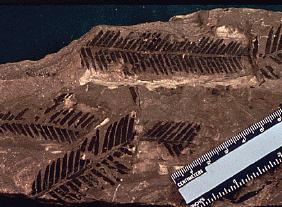







Cycads are an ancient group of seed plants. They first appeared in the Pennsylvanian and so have existed for approximately 300 million years, appearing before there were dinosaurs, existing alongside them, and perhaps being eaten by them. Unlike the dinosaurs, however, the cycads never became extinct; they are still with us, although they are not now as abundant or diverse as in their Mesozoic hey-day.
 In the Mesozoic,
cycads were an abundant component of the flora. During the
Triassic and Jurassic, the time of their greatest diversity, cycads made
up 20% of the world flora. For this reason the Mesozoic, and especially the
Jurassic, is often referred to
as the "Age of Cycads". During this time, they were an important
component of the vegetation, not simply in numbers of species, but in size
and number of individuals. Cycads were the trees and shrubs which, along
with the conifers and Ginkgoales, dominated the Mesozoic forests.
In the Mesozoic,
cycads were an abundant component of the flora. During the
Triassic and Jurassic, the time of their greatest diversity, cycads made
up 20% of the world flora. For this reason the Mesozoic, and especially the
Jurassic, is often referred to
as the "Age of Cycads". During this time, they were an important
component of the vegetation, not simply in numbers of species, but in size
and number of individuals. Cycads were the trees and shrubs which, along
with the conifers and Ginkgoales, dominated the Mesozoic forests.
In the past, cycads attained a global distribution, extending over the Earth from Alaska and Siberia to the Antarctic. Fossils are known from every continent, a feat that was possible because of the generally warmer climate of the Mesozoic, and higher moisture than today. The family Stangeriaceae, which today is restricted to small portions of Africa and Australia, existed in Argentina and the British Isles. The fossil depicted at right is a cycad-like fossil leaf assigned to the genus Ptilophyllum, common in the flora of Gondwana through most of the Mesozoic. This leaf may actually belong to another group, the Bennettitales, which are very similar in their morphology to cycads, and are often difficult to distinguish from them.
Leaves are only one of the structures preserved in the fossil record. We have also found fossilized stems, cones, and seeds, all of which help us to reconstruct the appearance and biology of these ancient plants. In addition to the eleven living genera, many of which are known as fossils, there are 19 extinct cycad genera known only as fossils. This figure does not include all the form taxa assignable to the Cycadales -- those leaf and stem fossils which have not been identifiable with a particular kind of cycad.


